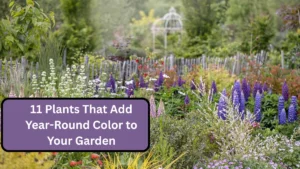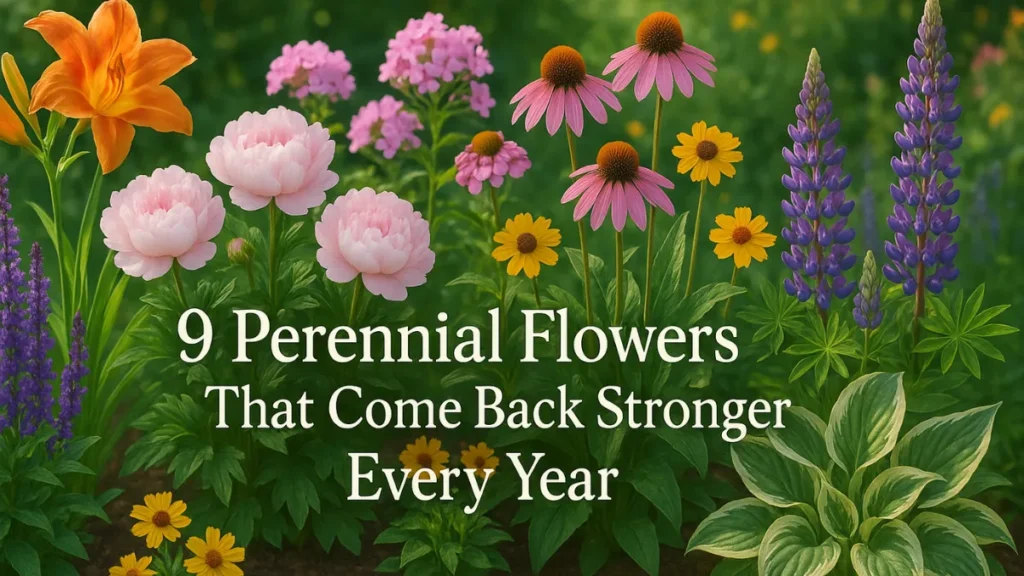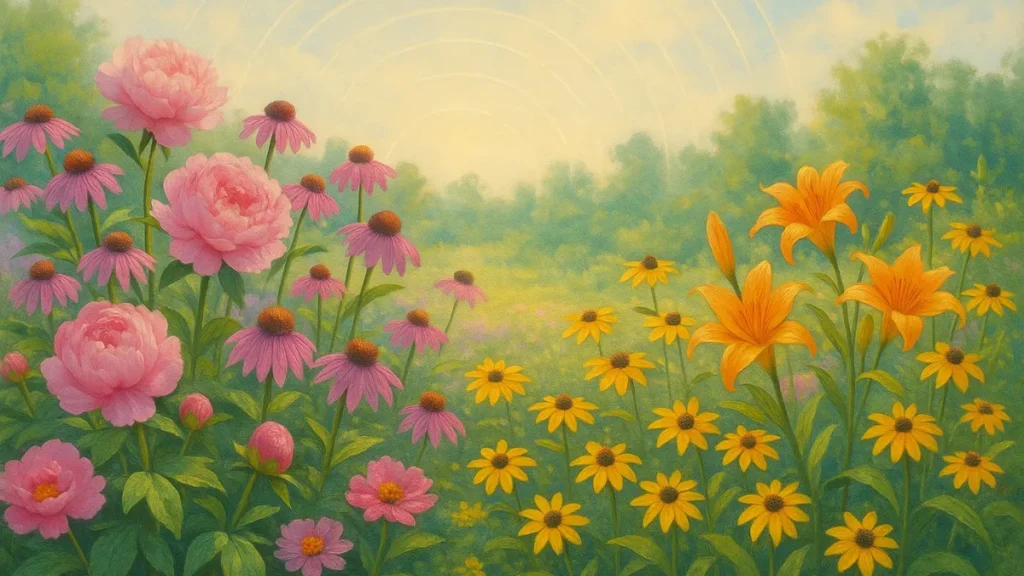If you’re looking to keep your garden vibrant throughout the year, choosing plants that offer year-round color is the perfect solution. Whether you’re aiming for a burst of spring flowers or winter interest, certain plants can provide a steady display of color through every season.
From the fiery red leaves of Japanese Maples in the fall to the bright berries of Winterberry Holly in winter, these plants ensure your garden stays alive with color.
Not only do they beautify your outdoor space, but they also attract wildlife like pollinators and birds, enhancing the ecosystem. In this blog, we’ll explore 11 stunning plants that will add lasting color and beauty to your garden all year long.
1. Japanese Maple (Acer palmatum)
Japanese Maple trees are a stunning addition to any garden due to their vibrant foliage that changes with the seasons. In spring, their leaves emerge in various shades of red, orange, or yellow, creating a colorful display.
As summer progresses, the leaves transition into a lush green, offering a calm and cooling effect. During fall, the foliage transforms again into fiery hues of red, orange, and gold, making it one of the best plants for year-round color. The delicate, finely cut leaves and compact size of many varieties make it perfect for smaller gardens or as a specimen tree.
Additionally, Japanese Maples can thrive in a variety of soil types, as long as they are well-drained. Whether placed in full sun or partial shade, these trees will not only enhance your garden’s aesthetic but will also provide a beautiful focal point throughout the year.
2. Evergreen Azalea (Rhododendron spp.)
Evergreen Azaleas are a favorite for adding year-round color to your garden, thanks to their vibrant blooms in spring and lush green foliage that remains attractive through the colder months.
These plants produce an abundance of flowers in various colors, such as pink, red, white, and purple, during springtime. After blooming, the glossy green leaves continue to provide structure to the garden, even during winter. Azaleas grow best in acidic, well-drained soil and thrive in partial shade, making them ideal for woodland or shaded gardens.
With many hybrid varieties available, there is an Azalea to suit nearly every climate and garden style. They are perfect for adding texture and depth, and their bright flowers serve as a brilliant contrast against winter’s dreariness.
3. Heuchera (Coral Bells)
Heuchera, or Coral Bells, is a versatile perennial plant known for its colorful foliage and ability to provide visual interest year-round. In spring and summer, Coral Bells showcase an array of leaf colors, including shades of red, purple, silver, and green, depending on the variety.
Their small, bell-shaped flowers emerge in late spring and can range from white to pink, adding another layer of interest. In the fall and winter, the evergreen nature of the leaves ensures that these plants continue to bring color and texture to the garden.
Heuchera thrives in partial to full shade and prefers moist, well-drained soil. It’s a great choice for border plantings, containers, or as a groundcover, offering both year-round color and low-maintenance care.
4. Sedum (Stonecrop)
Sedum, commonly known as Stonecrop, is a hardy, drought-tolerant perennial that provides year-round color with its varied foliage and seasonal blooms. In the spring and summer, Sedum varieties like ‘Autumn Joy’ offer thick, fleshy leaves that are typically green or blue-green, with some varieties featuring burgundy edges.
These plants are particularly attractive in late summer when their large clusters of star-shaped flowers bloom in hues of pink, red, or yellow, often attracting pollinators like bees and butterflies. As the season transitions into fall, Sedum’s blooms deepen in color, adding warm tones to the landscape.
Even in winter, the dried flower heads continue to stand tall, providing a unique texture and visual interest. Sedum thrives in full sun and well-drained soil, making it a perfect addition to rock gardens or low-maintenance landscapes.
5. Winterberry Holly (Ilex verticillata)
Winterberry Holly is a deciduous shrub that shines in winter when most other plants have lost their leaves. This plant is known for its bright red or orange berries that persist throughout the cold months, providing an essential burst of color against a backdrop of snow or frost.
During the warmer months, Winterberry Holly offers attractive green foliage and small, white flowers that appear in early summer, often hidden by the foliage. While the plant itself may seem unremarkable outside of winter, it’s these berries that make Winterberry Holly such a standout feature in gardens.
It thrives in moist, acidic soil and can be planted in full sun or partial shade. To ensure good berry production, it’s best to plant a male variety alongside female plants, as they require cross-pollination.
6. Lenten Rose (Helleborus orientalis)
Lenten Rose, or Helleborus, is a perennial that blooms in late winter or early spring, making it one of the first plants to bring color to the garden after the cold months. The plant features large, showy flowers that come in various colors, including white, pink, purple, and green, depending on the variety.
The leathery, evergreen leaves of Helleborus remain intact through winter, offering year-round foliage and color. Lenten Roses are tolerant of a range of soil types, though they prefer well-drained, slightly acidic soil. These plants thrive in partial to full shade, making them perfect for woodland gardens or shaded areas where other plants may struggle.
Their early blooms are not only a welcome sight in early spring but also attract pollinators like bees, which helps promote biodiversity in the garden.
7. Daylilies (Hemerocallis)
Daylilies are a popular perennial that can add vibrant color to your garden throughout the summer months. Known for their bold, trumpet-shaped flowers in a range of colors, including yellow, orange, red, and purple, Daylilies bloom in waves, with some varieties even blooming repeatedly throughout the growing season.
The leaves are grass-like, creating a soft, green backdrop to the vivid flowers. While Daylilies are known for their summer color, they also provide visual interest in the garden with their neat clumping growth habit and striking flower shapes.
Daylilies are highly adaptable and can grow in almost any soil type, provided it’s well-drained. They also tolerate a wide range of sun exposure, from full sun to light shade, making them an easy and reliable addition to a variety of garden settings.
8. Creeping Jenny (Lysimachia nummularia)
Creeping Jenny is a fast-growing groundcover that offers year-round color and texture to the garden. In the spring and summer, this low-growing plant boasts vibrant green or yellow-green leaves that spread quickly to fill in gaps in the garden.
In the fall, the leaves take on shades of gold and orange, adding a seasonal pop of color. During the winter, Creeping Jenny’s foliage remains semi-evergreen, offering a subtle touch of color even when most other plants are dormant.
This hardy plant thrives in both full sun and partial shade, and it prefers moist, well-drained soil. It’s ideal for planting in hanging baskets, along the edges of garden beds, or as a groundcover in areas that need a splash of color all year round.
9. Lavender (Lavandula angustifolia)
Lavender is a fragrant, drought-tolerant perennial that offers both visual and aromatic interest year-round. In the summer, Lavender plants produce spikes of purple, blue, or white flowers that attract pollinators such as bees and butterflies.
The silver-green foliage remains attractive through the growing season, and even in winter, its scent lingers when you brush against it. Lavender thrives in full sun and well-drained, sandy soil, making it an ideal plant for Mediterranean-style gardens, herb gardens, or as a border plant.
Its evergreen nature and ability to retain structure and color, even in colder months, make it a valuable plant for year-round garden interest. Furthermore, its ability to withstand dry conditions makes it a low-maintenance choice for gardeners.
10. Coneflower (Echinacea)
Coneflower, or Echinacea, is a hardy perennial known for its vibrant, daisy-like flowers that bloom in late summer to fall. These flowers come in shades of pink, purple, white, and orange, and their distinctive cone-shaped centers add a unique architectural element to the garden.
While the blooms are the main attraction, the plant also features sturdy, dark green leaves that provide a solid backdrop for the flowers. Coneflowers are known for their ability to attract pollinators, especially bees and butterflies.
They are drought-tolerant and thrive in full sun, making them a great addition to naturalized gardens or pollinator-friendly landscapes. In addition, the seed heads left behind after flowering provide food for birds, adding an additional layer of wildlife benefit.
11. Boxwood (Buxus)
Boxwood is a classic evergreen shrub that provides year-round color and structure to gardens. Known for its dense, compact growth and small, glossy leaves, Boxwood can be easily shaped into hedges or topiary.
The rich green foliage of Boxwood remains vibrant throughout the seasons, even in winter, offering a calming contrast to other plants that may die back in the colder months. These plants are incredibly versatile and can be used to create formal garden borders, provide privacy, or act as a backdrop to seasonal flowering plants.
Boxwood thrives in well-drained, slightly acidic soil and does best in partial to full sun. Its low-maintenance nature and evergreen appeal make it a staple in gardens looking for consistent color and structure throughout the year.
Bottom Line
Adding plants with year-round color is a fantastic way to ensure your garden remains lively and visually appealing, regardless of the season. By incorporating evergreens, colorful perennials, and flowering shrubs, you can enjoy a dynamic garden that attracts wildlife and enhances the landscape. With careful selection, these plants will thrive year-round with minimal maintenance, offering you beauty and joy throughout the seasons.
FAQs
What are the best plants for year-round color?
Some of the best plants include Japanese Maples, Heuchera, Winterberry Holly, and Daylilies.
Do plants with year-round color need a lot of maintenance?
Many of these plants are low-maintenance, especially drought-tolerant varieties like Lavender and Sedum.
Can I grow year-round color plants in containers?
Yes, most of these plants, like Boxwood and Heuchera, can thrive in containers as long as they have the right soil and sunlight.
How can I ensure year-round color in my garden?
Choose a variety of plants that bloom in different seasons, such as Lenten Rose for early spring and Coneflower for late summer, to maintain color all year.



